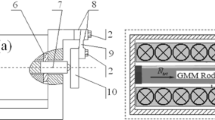Abstract
In this paper, a magnetomechanical coupling constitutive relation of the giant magnetostrictive material was investigated experimentally and theoretically. A grain-oriented magnetostrictive rod of iron and rare earth was tested under a combined magnetomechanical loading. Two types of experimental curves were obtained, i.e., the magnetostrictive curve of the extensional strain vs the magnetic field, and the curve of the magnetic polarization intensity vs the pre-stress. A new theoretical constitutive model, based on the density of domain switching, is developed. Comparison of the theoretical predictions with the experimental results indicates that this model can capture the main characteristics of the magnetoelastic coupling deformation of a giant magnetostrictive rod.
Similar content being viewed by others
References
Clark AE. Magnetostrictive rare earth-Fe2 compounds. In: Wohlfarth EP ed. Ferromagnetic Materials, Vol 1. Amsterdam: North-Holland Publishing Company, 1980. 531–589
Greenough RD, Jenner AG, Schulze MP, et al. The properties and applications of magnetostrictive rare-earth compounds.J Magn Mag Matter, 1991, 101: 75–80
E. du Tremolet de Lacheisserie, MaCkay K, Betz J, Peuzin JC, From bulk to film magnetostrictive actuatuors.Journal of Alloys and Compounds, 1998, 275: 685–691
Pratt JR, Oueini SS, Nayfeh AH. Terfenol-D nonlinear vibration absorber.J Intelli Mat Syst & Stru, 1999, 10: 29–35
Carman GP Mitrovic M. Nonlinear constitutive relations for magnetostrictive materials with applications to 1-D problems.J Intelli Mat Syst & Stru, 1996, 6: 673–683
Clark AE, Spano ML, Savage HT. Effect of stress on the magnetrostriction and magnetization of rare earth-Fe1.95 alloys.IEEE Trans Magnetics, 1983, Mag-19(5): 1964–1966
Wan YP. Study on the constitutive relation and fracture behavior of the magnetostrictive material. [Ph D Dissertation], Beijing: Dep Egn Mech, Tsinghua Uni, 2002
Moffet MB, Clark AE, Wun-Fogle M, Linberg J, Teter JP, McLaughlin EA. Characterization of Terfenol-D for magnetostrictive transducers.J Acoust Soc Am, 1991, 89(3): 1448–1455
Kannan KS, Dasgupta A. Nonlinear finite element scheme for modeling the magnetoelastic response of magnetostrictive smart structures.SPIE, 1994, 2190: 182–193
Wohlfarth EP. Ferromagnetic Materials, A Handbook on the Properties of Magnetically Ordered Substances. Vol 1. Amsterdam: North-Holland Publishing Company, 1980
Zhong WD. Ferromagnetism Vol 2. Beijing: Science Press, 1992(in Chinese)
Hom CL, Shankar N. A fully coupled constitutive model for electrostrictive ceramic materials.J Intelli Mat Syst & Stru, 1994 5: 795–801
Author information
Authors and Affiliations
Additional information
The project supported by the National Natural Science Foundation of China (10025209, 10132010, 10102007)
Rights and permissions
About this article
Cite this article
Yongping, W., Daining, F., Soh, A.K. et al. Experimental and theoretical study of the nonlinear response of agiant magnetostrictive rod. Acta Mech Sinica 19, 324–329 (2003). https://doi.org/10.1007/BF02487809
Received:
Revised:
Issue Date:
DOI: https://doi.org/10.1007/BF02487809




